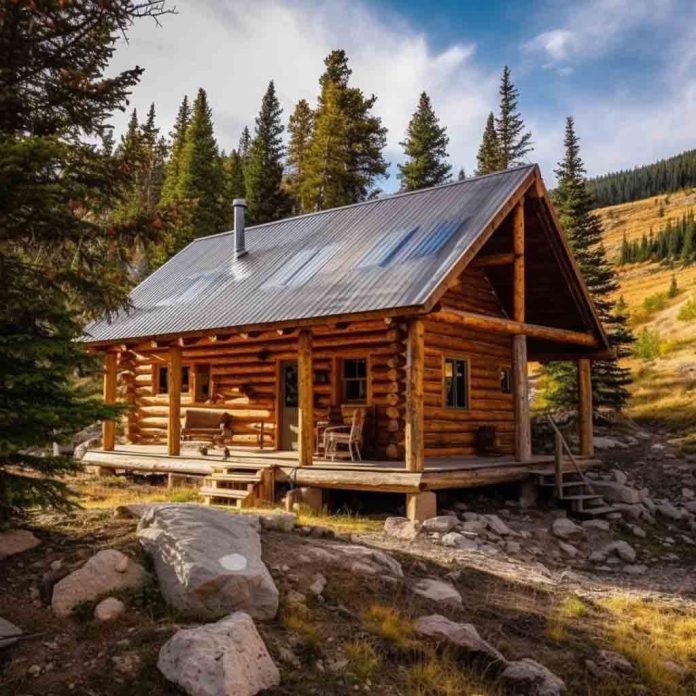Build Your Off-Grid Cabin Using Materials From Your Own Land
Dreaming of a tranquil retreat nestled in the wilderness? Here’s how you can build a cabin for free with the materials found on your land.
Building an off-grid cabin can be a fulfilling endeavor, providing you with a self-sustainable haven away from the hustle and bustle of modern life.
By carefully selecting the right land and utilizing the materials available on-site, you can construct a cabin without spending a fortune on lumber and other building supplies.
In this article, we will explore the key steps to building an off-grid cabin while maximizing the resources offered by the land itself.
Choose the Right Land
The foundation of building an off-grid cabin lies in selecting the right land.
Look for a property that offers an abundance of natural resources like timber, stone, and clay.
A wooded area with mature trees provides an excellent source of lumber, while a nearby water source can be used for various construction needs.
Ensure the land is suitable for habitation and meets any local regulations or restrictions.
Design Your Cabin
Before diving into construction, it’s essential to have a well-thought-out cabin design.
Consider the number of rooms, size, and layout to optimize your space.
Keep in mind the natural features of the land, such as the direction of sunlight, wind patterns, and the slope of the terrain.
Designing a cabin that harmonizes with the environment ensures energy efficiency and a more seamless integration with the surrounding landscape.
Harvest Timber Responsibly
One of the primary advantages of choosing land rich in natural resources is the availability of timber for construction.
When harvesting timber, prioritize responsible and sustainable practices.
Identify mature trees that can be felled and processed into usable lumber for your cabin’s framework, walls, and floors.
Research proper tree-cutting techniques to ensure safety and maximize the quality and yield of the harvested timber.
Gather Local Stone and Clay
If your land contains natural stone formations or clay deposits, take advantage of these materials in your cabin’s construction.
Stones can be used for foundation, walls, and even as a decorative element.
Clay, when mixed with sand and straw, can form a durable and insulating material called cob, which can be used for walls or even sculpting furniture and artistic features.
By utilizing these locally available resources, you reduce the need for external materials and minimize costs.
Incorporate Earth-Friendly Techniques
When building your off-grid cabin, consider incorporating earth-friendly techniques to enhance sustainability.
Utilize passive solar design principles by positioning windows strategically to maximize natural light and heat.
Implement proper insulation using locally sourced materials like straw, wood chips, or recycled denim.
These techniques not only reduce your environmental footprint but also contribute to long-term energy efficiency and cost savings.
Utilize Salvaged and Repurposed Materials
In addition to materials available on your land, consider incorporating salvaged and repurposed materials into your cabin’s construction.
Look for reclaimed wood, windows, doors, and other building components from local salvage yards or online platforms.
Not only does this reduce costs, but it also adds character and uniqueness to your cabin.
DIY Construction and Community Support
Building an off-grid cabin is a labor-intensive process, but it can be a rewarding do-it-yourself project.
Enlist the help of family and friends who share your vision, and organize workdays to tackle different aspects of the construction process.
This not only speeds up the project but also fosters a sense of community and shared accomplishment.
Building an off-grid cabin using the materials available on your land is a gratifying endeavor that promotes self-sufficiency and sustainability.
By selecting the right land abundant in natural resources, responsibly harvesting timber, gathering local stone and clay, and incorporating earth-friendly techniques, you can construct a cost-effective and environmentally conscious cabin.
Remember to leverage salvaged and repurposed materials and enlist the support of a community to make your off-grid cabin a reality.
Embrace the journey of creating your haven in harmony with the land and relish in the rewards of a self-built, off-grid retreat.
Here are ten types of off-grid shelters that can be built using materials found on your land:
- Log Cabin: Constructed using harvested timber from the land, a log cabin offers a rustic and cozy retreat in the wilderness.
- Stone Cottage: Utilizing stones sourced from the land, a stone cottage provides durability, natural insulation, and a charming aesthetic.
- Earthbag House: Earthbags, filled with soil from the land, form the walls of this sustainable and energy-efficient shelter.
- Cob House: Made from a mixture of clay, sand, and straw, cob houses offer a unique and organic structure with excellent thermal properties.
- Straw Bale House: Bales of straw, readily available from crop fields, are stacked to create walls that provide insulation and soundproofing.
- Timber Frame Cabin: Constructed using the timber from the land, a timber frame cabin showcases a beautiful exposed wooden frame and offers a sturdy structure.
- Underground Bunker: Utilizing the natural earth, an underground bunker provides protection and insulation from the elements while maximizing space efficiency.
- Cordwood House: This type of shelter uses logs or short lengths of wood, called cordwood, to build walls, offering an aesthetically pleasing and energy-efficient option.
- Adobe House: Made from a mixture of clay, sand, and organic materials, adobe houses are well-suited for warm climates and provide natural insulation.
- Thatched Hut: By using locally sourced materials like grass, straw, or reeds, a thatched hut offers a traditional and sustainable shelter option.
Remember, the availability of specific materials on your land will dictate which type of shelter is most suitable.
Adapt and customize the design based on the resources readily available to you.

